Factors Effect on M-Government Adoption in Kuwait
Abstract
Technological development has significantly influenced the application of mobile technologies and currently, the government agencies are intensely focusing on influencing the citizens to adopt and use the mobile government or M-government services. However, it is quite clear that in order to motivate the citizens it is important for the government to increase their engagement through enhancing the efficiency rate of the government services. Several governments, including the government of Kuwait, have already initiated to move towards developing and implementing the mobile government project and the main aim of the government is to increase the interaction with the citizens for increasing the service quality and delivery processes. This research has critically developed and analysed the existing technology acceptance theories and models for the development of the evaluation framework and this paper has also introduced an effective conceptual model for the citizens of Kuwait to adopt M-government services for promoting national growth. In order to collect the data for this research, the citizens of Kuwait have been targeted and a survey has been conducted through developing questionnaires. Moreover, the proposed framework has been tested empirically through the following structural equation modelling and the data has been collected directly from the structured questionnaire. The findings have mainly addressed the perceived usefulness, awareness, compatibility, face-to-face interaction and social influence in a significant manner and this research has contributed to predicting the main intention of using the M-government services.
Introduction
Based on the massive advancement of technology, the IT industry has experienced significant growth and has also raised the demand for efficient and effective government services and that is the reason the government of Kuwait has adopted e-government infrastructure for delivering online or e-services to the government agencies, organizations, businesses and citizens for better information access. Considering this, mobile technology can be considered as an exceptional service line that can change as well as integrate communication and learning activities (Ali and Kabbi, 2018, p.375). The most important thing is that it can change human-computer interaction. Therefore, M-government is quite an essential case for the population of Kuwait as it can facilitate the lifestyle of the people by developing the availability of the government services on smartphones rather than following the traditional approach where the people have to visit the government offices and agencies for requesting information, form fills up and applies for new services. Thus, it can reduce a lot of physical effort of the people and can reduce the time which is mainly wasted though travelling to the location of the government agencies. By increasing the availability of the government services through giving mobile access the people can easily afford and use the services at anytime from anywhere. The main forces which motivate the citizens in adopting the M-government, as well as e-government, are the emergence of mobile internet, penetration of smartphone devices, and smartphone services and net application (Rouibah et al. 2019, p.25). The penetration rates of internet-enabled smartphones are dramatically increasing in comparison to the use of traditionally wired personal computers and this significant growth has changed the way the population has perceived the functionality of their smartphones (Jasimuddin et al. 2017, p.1307).
Based on technological advancement, currently, the need for voice communication has significantly reduced because of the emergence of multiple convenient connectivity systems for using the internet, exchanging emails, transferring data, as well as managing business transactions. Based on reviewing multiple literature it has been identified a potential gap investigation of the crucial factors which can affect the population from adopting and using the M-government services within Kuwait (Alotaibi and Roussinov, 2017, p.19). However, those studies have addressed the adoption process of e-government services but not the processes of M-government services. Therefore, in order to address this gap, it is required to analyse the factors which can influence the population to adopt the M-government services in Kuwait. The mobile government mainly provides effective support to the citizens of Kuwait to access the online services and facilities for performing the tasks which are associated with the government agencies. For example, using the M-government, the citizens of Kuwait will be able to respond to instant data regarding traffic accidents. Thus, the Police agency will be able to inspect the PDA or smartphone submitting the data or report to the branch offices while accessing from the accident location (Almuraqab and Jasimuddin, 2017, p.12). Moreover, the government can also use M-services to exchange and transfer emergency data related to wildfires, homeland security, natural calamities, and so on to the national population. Considering the rapid enhancement of the usage of mobile technology, nowadays almost in all types of workplaces, the users of mobile phones have become almost 100%. Thus, it has become quite easy for the government to increase the accessibility and availability of mobile government services through linking with the government services from anywhere and anytime as well as almost for everyone.
Keeping the evolution of the new technologies aside the government can easily facilitate the mobile government approach for multiple organizational and cultural changes according to the diversified governmental field.
According to several critical success factors associated with the mobile government, user acceptance can be considered an effective one. Therefore this study will mainly focus on measuring the acceptance of the users towards mobile government services through detecting the significance and role of the different factors in the perspectives of the overall population. Moreover, considering the review of different pieces of literature multiple models and theories will be adopted for building an effective conceptual model for promoting m-government adoption.
Research Model and Hypothesis
Considering the measurement of the user acceptance it is quite important to analyze the suitability of the application of the provided system and in case of measuring the behaviour of the users, there are mainly two effective models, such as TAM or Technology Acceptance Model and UTAUT or Unified Theory of Acceptance and Use of Technology (Althunibat et al. 2021, p.300).
There are multiple studies that have addressed different factors for measuring the acceptance of the users. For instance, considering the e-banking process, some investigators have stated that the perceived usefulness, perceived ease of use, security and privacy can be considered as the most crucial variables that can motivate the users to adopt new services (Alsaadi et al. 2019, p.15). Another study has argued that social influence and self-efficiency are the two crucial factors that can highly influence the perceived usefulness and perceived ease of use for utilizing mobile internet (Rouibah et al. 2018, p.19). In a consequent manner, there are some other major variables that have come with the other models and theories and these variables are widely similar to the factors associated with the TAM or Technological Acceptance Model (Djamal and Renaldi, 2017, p.4). The next portion of the research will address those factors which will be utilized for the study of examining the acceptance of the citizens towards the mobile government (Almaiah and Nasereddin, 2020, p.236). There will be some subsections where it will address the factors associated with the model as well as hypotheses that may be adopted by the previous studies and the major approaches in terms of user acceptance.
Mainly there are six factors that will be addressed and for each factor, an individual hypothesis will be developed.
Social influence
The TPB or Theory of Planned Behaviour and TRA or Theory of Reasoned Action are mainly addressed the SI or Social Influence which is a crucial factor for determining the usage and acceptance of technology (Mensah and Mi, 2017, p.40). In the earlier stages, Social Influence is considered to be a significant variable than the later stages. It mainly helps in motivating the social and cultural needs of the citizens prior to delivering new technologies and mainly enhances the usage and acceptance of the delivered technologies (Rouibah et al. 2019, p.25). Therefore, the proposed hypotheses are the following.
H1a– SI or Social Influence delivers a positive impact over the usage behaviour of the M-government services
H1b– SI or Social Influence has a positive impact on the behavioural intention towards the usage of M-government services.
Facilitating Condition
In order to ensure the acceptance of the users towards the price of the provided services through M-government in comparison with the genuine or traditional office services. The benefits of the users are highly clarified and promoted, especially in the time of proposing new services in the market (Eid et al. 2020, p.17). Moreover, the value of the new services will need to be quite reasonable which can allow the users to adopt the new services. However, the effect of the cost may affect the accessibility of the users to the information and government services either positively or negatively (Almuraqab and Jasimuddin, 2017, p.22). Furthermore, the cost of services will need to reflect the value of the individual services properly.
H2– Facilitating Condition may negatively affect the behavioural intention towards the usage of government services.
Perceived Risk in Technology
PRT or Perceived Risk in Technology has played a crucial role in minimizing the perceived risks of utilizing new and advanced technologies, especially to the transactional technologies where uncertainty is involved (Al-Omairi et al. 2020, p.52). Based on the adoption of the M-government is still at its early stage in different developing countries like Kuwait, the citizens are not confident enough about the usefulness and technical capability of the service providers who may deliver the M-government services (Almuraqab, 2017, p.11). Moreover, security is another major concern where several queries have been raised regarding the reliability of the provided services. Adoption behaviour, requirements and preferences of the citizens may affect in a significant manner due to different cross-cultural characteristics (Alsaadi et al. 2019, p.47). The adoption behaviour towards m-government can be analysed by giving additional focus on the cultural differences.
H3– Perceived Risks in technology can promote a positive impact on the BI or Behavioural Intention towards the usage of M-government services.
Perceived Usefulness
PU or Perceived Usefulness is quite an important variable that is mainly associated with the delivered information and it is highly concerned about the meaning, relevance, information, importance, significance and support the data associated with the services are for the decision of the users. The most important thing associated with the PU is that the user is able to earn money by using the specific application or services (Persada et al. 2019, p.19). Therefore, the proposed hypothesis is the following.
H4– The impact of the PU or Positive Usefulness is quite positive over the BI or Behavioural Intention while using the Mobile Government services.
Perceived Ease of Use
PEOU or the Perceived Ease of Use is a major factor that can be utilized while analysing or detecting the acceptance of the newly proposed technology (Ahmad and Khalid, 2017, p.370). Based on the result of previous studies Perceived Ease of Use or PEOU can make an indirect impact on the BI or Behavioural Intention for the usage of new technology and make a direct impact on the attitude of the users towards technology usage. It mainly represents the user’s flexible ease of service users as well as the error-free usage (Zheng and M,2021, p.5). Therefore, the proposed hypothesis is the following.
H5– PEOU or Perceived Ease of Use can make a positive impact over PU or Perceived Usefulness regarding Mobile Government services.
BI or Behavioural Intention
Generally, BI or Behavioural Intention refers to a crucial factor and it mainly focuses on predicting the intention of the users for utilizing the new technologies (Mensah and Mi, 2019, p.160). It is considered as a crucial predictor, which can assume the positive impact of the BI or Behavioural Intention over the attitude towards usage of the proposed technology (Almaiah et al. 2020, p.11). An intention of a user towards using the M-government service can be related to the real usage of the services. Mainly the intention of the user represents the loyalty of the user, which generally varies upon multiple factors, such as perceived trust, social influence, ease of use, and so on. Based on the analysis, the proposed hypothesis is the following.
H6– BI or Behavioural Intention significantly affects the usage behaviour for utilizing different Mobile Government Services.
Research Method
In order to conduct research, it is important for a researcher to follow some specific methodological tools, which mainly help the individual to collect and analyse the potential data in an efficient manner. This section will be addressed these methodological tools and their application.
Collection of Data
In this study, the overall population of Kuwait can be an important target and for their teach-savvy approach towards new technologies associated with wireless technology and mobile devices, this study has mainly followed structured surveys as the effective data collection tool. Considering the adoption of the primary quantitative data collection approach, a set of questionnaires has been designed with the help of previous studies and researches. The individual questions have been developed by following the 5 points Likert Scale process by fixing the range from strongly disagree to strongly agree. As this research is empirical research, therefore, selecting the survey research method is considered an appropriate approach for testing the research model (Alonazi et al. 2019, p.26). The data collection process was started in February 2021 in the capital Kuwait City that is the cultural, political, and economic hub of Kuwait. The data has been collected randomly from 550 citizens of Kuwait who have already started to use Mobile Government services as well as have the interest in adopting and using the same services in future. After collecting the responses from the randomly targeted respondents, the researcher has mainly done reliability tests for measuring the individual construct for assessing the effective measures and has indicated the accuracy of the measurement process. The questionnaire mainly consisted of seven sections and the first section mainly illustrates the demographic information, the next sections illustrate the elicited information regarding the factors associated with the proposed research model (Alomari, 2021, p.5).
Sampling Profiler
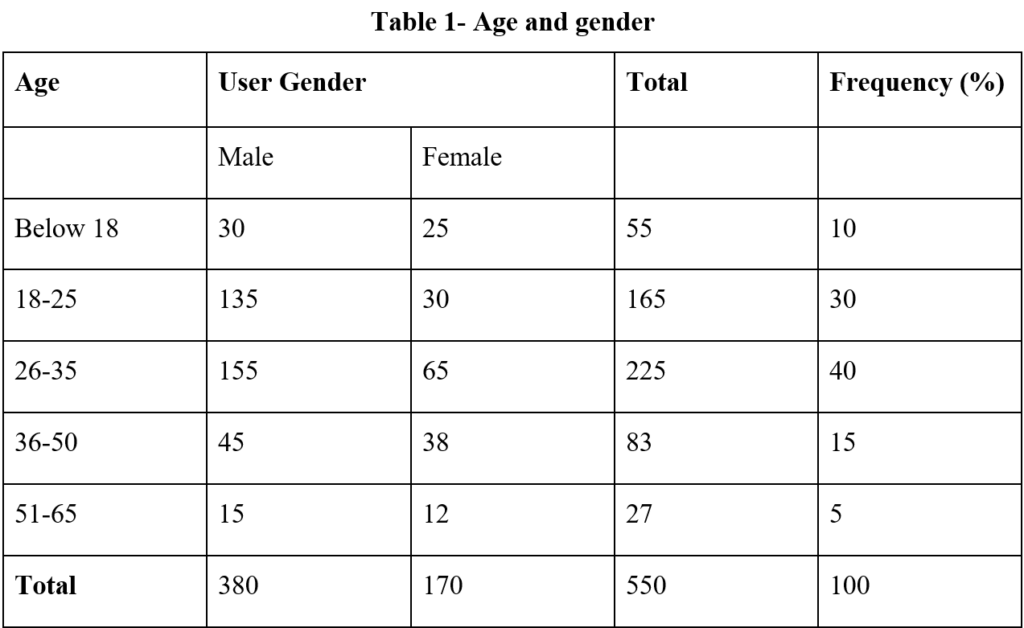
(Source: Self-developed)
Based on the above table, it is quite clear that the demographic distribution between the male and female gender refers to 69% male respondents and 31% female respondents. Considering the gender differentiation, the researcher has collected responses from those respondents with the age range of <18-65 years old. Moreover, most of the respondents were the age level of 18-35 years old. The survey has been conducted over multiple platforms, such as face-to-face interaction, SMS, Radio, Internet, Newspaper and Magazine. Therefore, figure 2 has explained that 30% of the citizens have delivered the responses through face-to-face approach, 20% of respondents have given responses through SMS, 10% have delivered responses through Internet, 15% respondents have provided their responses through Radio and the rest 25% have delivered their responses through newspapers and magazines (Almuraqab, 2021, p.7).
Questionnaire Design
The questionnaire has mainly developed for gathering the potential information where each of the questions has been developed based on the effectiveness of the proposed model. The questionnaire mainly has consisted of two types of questions, as the first question is a demographic question which has mainly MCQ type options (such as Below 18, 18-25, 26-35, 36-50, 51-65) and the rest six questions are 5-point scaled questions with the options strongly disagree, disagree, neutral, agree, strongly agree (Abdullah et al. 2018, p.832).
Data Analysis
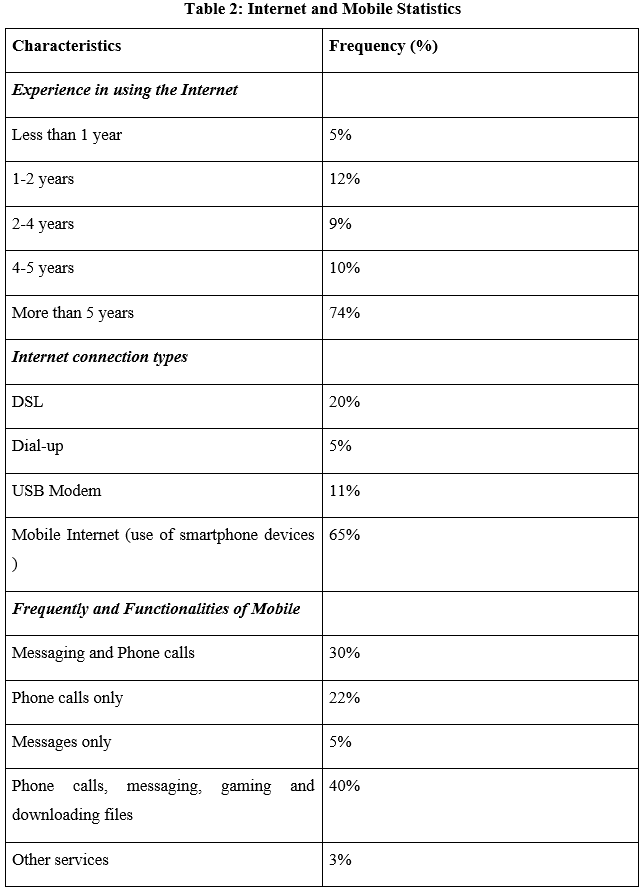
(Source: Self-developed)
Based on table 2, it is quite clear that 74% of the respondents of Kuwait have experience using the internet for more than five years and it has been addressed previously that the age range between 16-25 for this is quite a positive sign that the participant has significantly engaged in surfing the internet on a daily basis. Based on the usage of different mobile functionalities, it has been analysed that 26% of the participants of Kuwait have access to the e-government portal of Kuwait and only 22% of those participants are able to use one of the e-government services (Abdullah et al. 2018, p.832). Those participants who have utilized the e-portal for inquiring about data or accessibility of the government facilities mostly belong to the youth generation of Kuwait. Based on table 2, it has been analysed that 40% of the respondents have engaged with using their smartphones for multiple purposes, such as phone calls, messaging, internet surfing, data downloading, and so on.
Generally, AMOS is considered to be one of the highly used SEM or Structural Equation Model for validating the structured information. In this research, the AMOS version 18.0 has been utilized for measuring and evaluating the generated and proposed hypotheses. There are mainly two types of analysis that have been conducted in this section- the first one is measurement model and the second one is analysis of the structural model which has already been recommended in the above section (Almuraqab and Jasimuddin, 2017, p.21).
Analyzing the Measurement model
According to the overall reliability tests of the questionnaire items- the 28 items addressed in Appendix 1 have been utilized in the research is 0,809. Based on multiple research work, it has been identified that the reliability of 0.70 is naturally considered as the acceptable structured data. Therefore, according to table 3, it is already addressed that the results of the reliability tests and all the values are above 0.70 which mainly refers to the evidence of existing well-structured data. According to table 3, the reliability test and the mean value of the individual items are mainly constructed within this study and the individual items have a minimum of three construct items (Ibrahim et al. 2017, p.12).
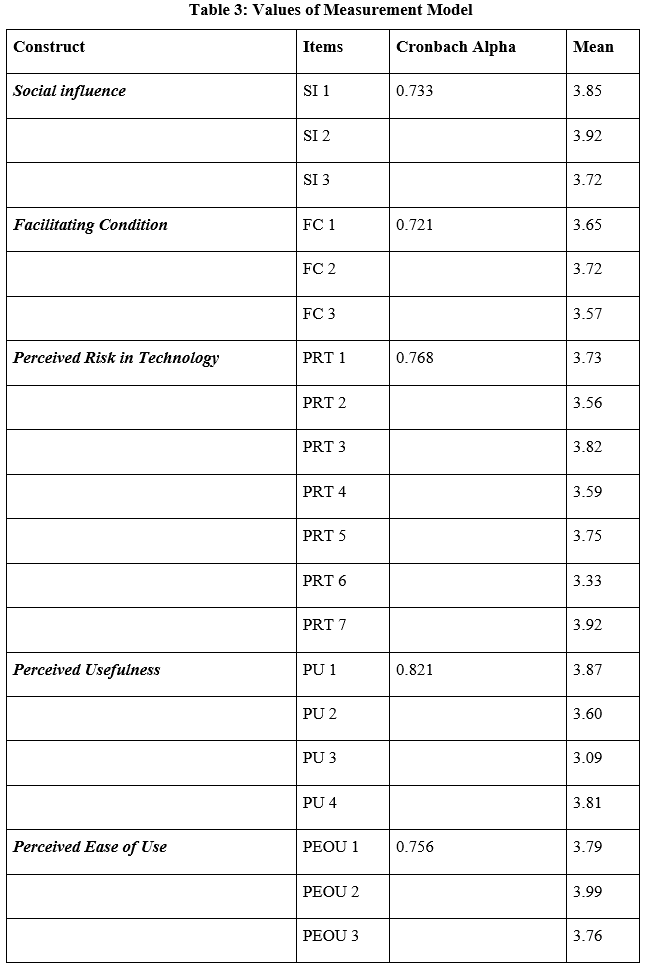
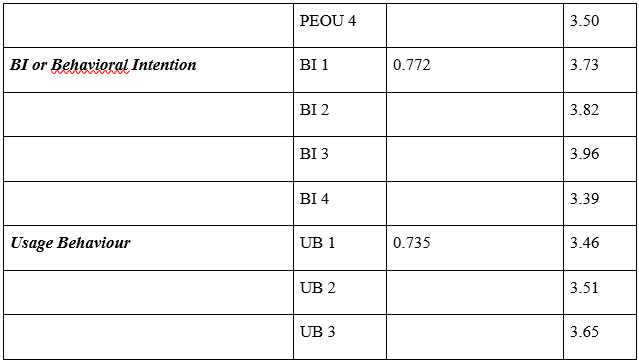
(Source: Self-developed)
Analyzing the proposed Structural model
The use of the Structural Equation Model or SEM analysis process generally delivers the investigators multiple approaches associated with the analysis of multiple models, such as latent variable analysis, confirmatory factor analysis, linear structural relations analysis, path analysis, covariance structure analysis, and so on (Rosenbaum et al. 2018, p.198). Therefore, the use of Structural Equation Model or SEM analysis is quite suitable and effective for measuring the potential of the genuine relationship between the individual constructs. According to the result addressed on table 4, the fit indices have been utilized for identifying the structural model as proposed by the previous researches. The outcomes of table 4 have addressed that all the measures stated in the tabular format are the recommended values which have directed the existence of a good model fit. The model proposed in figure 1 in the above section addresses that the regression test of the model hypothesis generally has indicated a stringer effectiveness over the population of Kuwait through which their behavioral intention towards using the M-government or mobile government services has become a SI or social influence with the value of 0.42 and it has been followed by the PRT or Perceived Risk in technology with the value of 0.31. It mainly addresses that quite a potential impact over the intentions of the citizens of Kuwait towards the usage of M-government or mobile government services. The path analysis has indicated that all the proposed hypotheses have been supported through the significant impact of the 0.01 level (Yuan and Ishak, 2021, p.129).
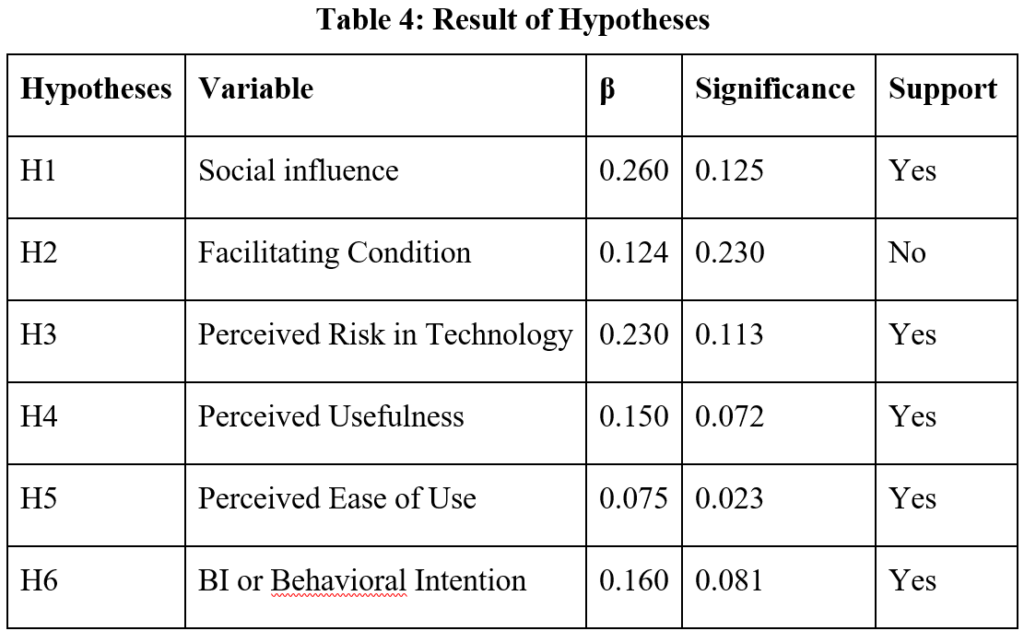
(Source: Self-developed)
According to the above table 4, it is quite clear that the table has addressed the result of the hypothesis testing and it has been analyzed that all the factors except the Facilitating Condition are significantly contributed to the assumption of the intended usage of M-government or mobile government services. As it is already addressed that this research has followed multiple regression analysis for testing the hypotheses, the main intention behind doing the regression analysis is to co-relate all the dependent variables for establishing a new set of independent variables and here the role of β is quite crucial because it has helped in comparing with the contribution of the individual independent variables for addressing the individual dependent variables. For instance, the social influence which has the biggest β value of 0.260 and it has the highest contribution towards the usage of mobile government services or M-government services generally followed by PRT or Perceived Risk in Technology with the β value of 0.230 (according to table 5) (Almaiah et al. 2020, p.52).
The overall analysis has addressed that the perceived usefulness, social influence, behavioral intention, Perceived risk in technology, and perceived ease of use are the factors which have significantly contributed towards the prediction of population intention towards the usage of M-government or mobile government services. On the other hand, facilitating conditions has insignificantly contributed to the population’s intention towards the usage of the M-government or mobile government services.
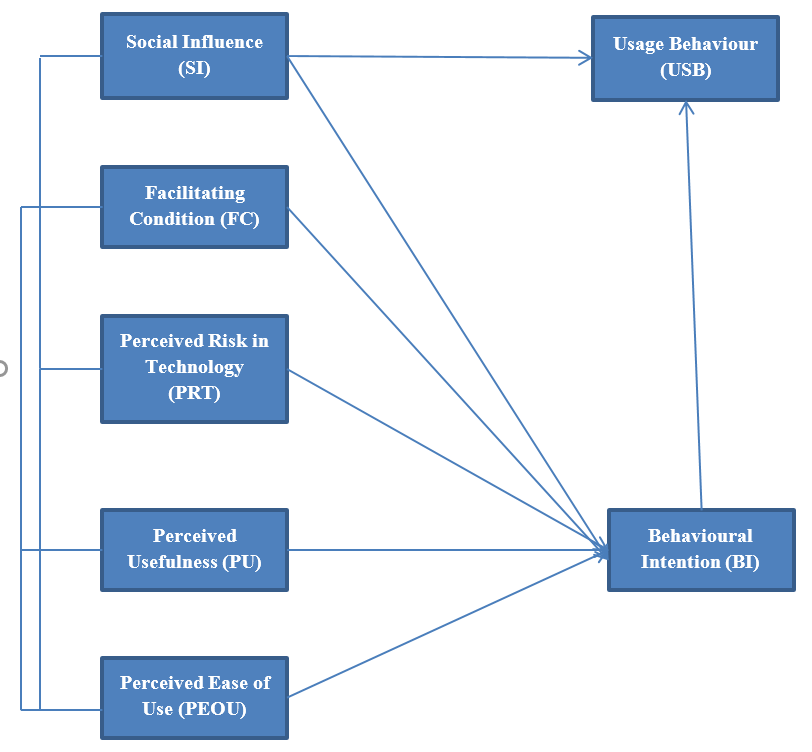
Figure 1: Proposed Research Model
(Source: Self-created)
Discussion
Considering the measurement process for analyzing the acceptance of the population towards the delivered government services is not the concern of this research but the associated variables which are included within the decision of the population are required to be examined properly. The considered variables can be associated with social or monetary characteristics related to the service. For instance, those services which are not crucial and not effective enough have created intense challenges in understanding the usage of M-government services. Here the SI or Social Influence has played a crucial role in motivating the behaviour of the Kuwait population for the acceptance of new technologies. Social Influence has been considered as quite an essential as well as crucial variable for having a large contribution within the adoption of technological studies (Saadi et al. 2017, p.45). The cultural reflection as well as social factors has significantly influenced the population of Kuwait who has accepted or have not been able to accept the new technologies according to their own social background as well as cultural beliefs (Nguyen et al. 2015, p.56).
After conducting the path analysis the potential outcomes have shown that, considering all the independent variables, SI or Social Influence has made its impact over the intention of the population in quite a significant manner regarding the use of M-government services. And it has also impacted genuine usage towards the behaviour of M-government or mobile government services along with the regression value of 0.260 and those outcomes have given the SI or the Social Influence variable as the first priority and all the factors have been affected by this particular factor through which the probability towards the acceptance of the M-government services by the population of Kuwait. Considering the second priority among the variables the PRT or Perceived Risk in Technology has significantly impacted the intention of the users where the regression value has come towards 0.230. Therefore, comparing with the other variables FC or Facilitating Condition has negatively impacted the intention of the citizens regarding the usage of Mobile Government. The regression value of 0.124 has indicated that if the facilitating condition somehow reduces; therefore the intention of the Kuwait population towards adopting the new technology of M-government will be increased (Rouibah et al. 2019, p.116).
Based on the outcomes revealed from the regression analysis, the PU or Perceived Usefulness is another important variable which has influenced the intention of the population towards the usage of mobile government services. Moreover, according to the analyzed data it has been confirmed that PEU or Perceived Ease of Use is intensely affected over behavioral intention (Ali and Kabbi, 2018, p.180). After correlating with the results of TAM based on the previous research, the findings of this study has indicated that, due to the behavioral intention of the population of Kuwait towards the M-government services, it is quite clear that it has the potential of affecting the actual usage behaviour. These are the potential evidence which have mainly come from the study conducted by Morris and AlAwadhi regarding their UTAUT and TAM researches (Liu et al. 2014, p.433). These are the outcomes which have mainly impacted the future research works and the researchers will remain more conscious while delivering any subjective data towards addressing the perceived usefulness of TAM for interpreting with any kind of service adoption associated with the context of M-government services (ME and RD, 2012, p.380). The result from the path analysis has indicated that the overall independent factors have quite a positive correlation among each other and among these factors the significant Correlation between the Perceived trust and Social Influence is almost 0.65. This is a crucial indication which has addressed that trust cannot be considered as a constant factor where change within the society can be promoted through the usage of mobile government services. Therefore, if the trust towards technology can be minimized then the SI or Social Influence will automatically reduce and it may negatively impact the intention of the population regarding the usage of mobile government services (Tamilmani et al. 2021, p.45). Moreover, the facilitating condition is highly correlated with the social influence and this significant correlation has addressed that if the facilitating condition gets restricted within the society then it will be discussed more and the probability of rising intention towards the usage of mobile government services will become higher (Almuraqab, 2021, p.3).
According to the implications associated with this research it has been directed to the developers or governments and implementers. These managerial bodies have highly required guaranteed usefulness and the ease of utilizing M-government technologies for experiencing highly trusted and secured technology along with the accessibility of low cost factors (Adeyemi and Issa, 2020, p.70). These factors mainly help in increasing the desire of the actual users towards the usage of M-government facilities by attracting the citizen’s intentions to the use of M-government. As a result, it has increased the performance of the government and saved both the time and cost of the organizations and population the enhancement of the citizen’s trust is considered to be a crucial motivation factor towards the society to talk about the M-government as well as its usage also (Persada et al. 2019, p.14). It mainly helps in increasing the intention towards usage. The contribution of this research towards the previous studies are quite helpful in analyzing the effectiveness of Social Influence, Facilitating Condition, Perceived Usefulness, Perceived Ease of Use, Perceived Trust over the behavioral intention towards the usage of M-government facilities (Dwivedi et al. 2020, p.15). At the same time, the effectiveness of these factors have influenced indirectly through the correlation between different independent variables which have significantly influenced the overall effectiveness on BI or Behavioral Intention towards the usage of Mobile Government as well as the behavioral usage (Dwivedi et al. 2019, p.720). In this particular research, it has been specifically addressed the mediated factors which may impact the acceptance of the population towards the mobile government. According to the past analysis, it can be said that, in order to gain more adoption of mobile government services, it is highly required to recommend the practitioners associated with the e-government services that the rearrange of the priorities towards those factors which need more focus can made the service deliverables more easy and useful for the population Kuwait in interference to use the services.
Conclusion
The overall research has critically addressed as well as reviewed the existing TAM or Technology Acceptance Models as well as frameworks where some effective as well as essential factors have been identified which are associated with the existing TAM models. Here, in this study, it has been significantly discussed the concept and perspective of newly developed M-government or mobile government services and after that it has been integrated to the proposed research model for measuring the acceptance of the users in mobile government services. The recommended model within this study has attempted to measure acceptance of the m-government approach among the population of Kuwait through using the SEM AMOS 18 for testing the hypotheses of the research. The outcomes associated with this study has indicated that the independent variables, such as Social Influence, Perceived Usefulness, Perceived Ease of Use, Facilitating Condition, Cost of Services, and so on have a direct and intense impact over the behavioral intention of the population towards the usage of M-government services and it has indirect impact over the actual use behaviour. Considering all of the impacts, SI or Social Influence has a major influence over the intention of the population towards the usage of mobile government technology. These are the major implications which have impacted over perceived trust in technology. Moreover, it is considered as a key to achieve the SI or Social Intention towards the use of mobile government services. Moreover, it can be assumed that these implications associated with the research can support the public sectors as well as the government bodies to achieve more knowledge regarding the way both acceptance and development can influence the M-government or mobile government services. Though this research has limited data on some specific factors, it can be said that the measurement of the effectiveness towards perceived risk over the acceptance of the citizens may bring valid outcomes related to the mobile government services.
Reference List
Abdullah, A.M., Naser, K. and Fayez, F., 2018. Obstacles toward adopting electronic government in an emerging economy: Evidence from Kuwait. Asian Economic and Financial Review, 8(6), pp.832-842.
Adeyemi, I.O. and Issa, A.O., 2020. Integrating information system success model (ISSM) and technology acceptance model (TAM): Proposing students’ satisfaction with university Web portal model. Record and Library Journal, 6(1), pp.69-79.
Ahmad, S.Z. and Khalid, K., 2017. The adoption of M-government services from the user’s perspectives: Empirical evidence from the United Arab Emirates. International Journal of Information Management, 37(5), pp.367-379.
Ali, H. and Kabbi, R.A., 2018. M-government applications: measurement of users’ satisfaction in the Kingdom of Bahrain. Electronic Government, an International Journal, 14(4), pp.375-388.
Alkhaldi, A.N., 2018. A MODEL OF THE MAJOR FACTORS AFFECTING USER’S INTENTION TO USE M-GOVERNMENT SERVICES IN SAUDI ARABIA: FROM USER’S PERSECTIVE. Journal of Global Business & Technology, 14(1).
Almaiah, M., Al-Khasawneh, A., Althunibat, A. and Khawatreh, S., 2020. Mobile government adoption model based on combining GAM and UTAUT to explain factors according to adoption of mobile government services.
Almaiah, M., Al-Khasawneh, A., Althunibat, A. and Khawatreh, S., 2020. Mobile government adoption model based on combining GAM and UTAUT to explain factors according to adoption of mobile government services.
Almaiah, M.A. and Nasereddin, Y., 2020. Factors influencing the adoption of e-government services among Jordanian citizens. Electronic Government, An International Journal, 16(3), pp.236-259.
Almarashdeh, I. and Alsmadi, M.K., 2017. How to make them use it? Citizens acceptance of M-government. Applied Computing and Informatics, 13(2), pp.194-199.
Almuraqab, N.A.S. and Jasimuddin, S.M., 2017. Factors that Influence End‑Users’ Adoption of Smart Government Services in the UAE: A Conceptual Framework. Electronic Journal of Information Systems Evaluation, 20(1), pp.pp11-23.
Almuraqab, N.A.S., 2017. M-government adoption factors in the UAE: a partial least squares approach. International Journal of Business and Information, 11(4).
Almuraqab, N.A.S., 2021. Introduction to the critical success factors of E-government adoption of the utilization of emerging smart cities technologies. In Solving Urban Infrastructure Problems Using Smart City Technologies (pp. 3-15). Elsevier.
Al-Omairi, L., Al-Samarraie, H., Alzahrani, A.I. and Alalwan, N., 2020. Students’ intention to adopt e-government learning services: a developing country perspective. Library Hi Tech.
Alomari, M.K., 2021. M-government trust framework: deployment of an empirical study amongst Jordanian youth. Transforming Government: People, Process and Policy.
Alonazi, M., Beloff, N. and White, M., 2019. Perceptions towards the adoption and utilization of m-government services: A study from the citizens’ perspective in saudi arabia. In Information Technology for Management: Current Research and Future Directions (pp. 3-26). Springer, Cham.
Alotaibi, S. and Roussinov, D., 2017, June. User acceptance of m-government services in Saudi Arabia: an SEM approach. In European Conference on Digital Government (pp. 10-19). Academic Conferences International Limited.
Alsaadi, M.R., Ahmad, S.Z. and Hussain, M., 2018. A quality function deployment strategy for improving mobile-government service quality in the Gulf cooperation council countries. Benchmarking: An International Journal.
Alsaadi, M.R., Ahmad, S.Z. and Hussain, M., 2019. Improving the quality of mobile government services in the Gulf Cooperation Council: A quality-function-deployment approach. Journal of Systems and Information Technology.
Althunibat, A., Binsawad, M., Almaiah, M.A., Almomani, O., Alsaaidah, A., Al-Rahmi, W. and Seliaman, M.E., 2021. Sustainable Applications of Smart-Government Services: A Model to Understand Smart-Government Adoption. Sustainability, 13(6), p.3028.
Djamal, E.C. and Renaldi, F., 2017, September. Developing citizen centric integrated systems for local community: An approach towards M-Government application. In 2017 International Conference on ICT For Smart Society (ICISS) (pp. 1-4). IEEE.
Dwivedi, Y.K., Rana, N.P., Jeyaraj, A., Clement, M. and Williams, M.D., 2019. Re-examining the unified theory of acceptance and use of technology (UTAUT): Towards a revised theoretical model. Information Systems Frontiers, 21(3), pp.719-734.
Dwivedi, Y.K., Rana, N.P., Tamilmani, K. and Raman, R., 2020. A meta-analysis based modified unified theory of acceptance and use of technology (meta-UTAUT): a review of emerging literature. Current opinion in psychology, 36, pp.13-18.
Eid, R., Selim, H. and El-Kassrawy, Y., 2020. Understanding citizen intention to use m-government services: an empirical study in the UAE. Transforming Government: People, Process and Policy.
Ibrahim, R., Hilles, S.M., Adam, S.M. and El-Ebiary, Y., 2017. Electronic government Services Usage, Adoption and Evaluation: A Review Paper. International Journal of Contemporary Computer Research, 1(1), pp.6-13.
Jasimuddin, S.M., Mishra, N. and A. Saif Almuraqab, N., 2017. Modelling the factors that influence the acceptance of digital technologies in e-government services in the UAE: a PLS-SEM Approach. Production planning & control, 28(16), pp.1307-1317.
Liu, Y., Li, H., Kostakos, V., Goncalves, J., Hosio, S. and Hu, F., 2014. An empirical investigation of mobile government adoption in rural China: A case study in Zhejiang province. Government Information Quarterly, 31(3), pp.432-442.
ME, A. and RD, G., 2012. Towards a UTAUT-based Model for the Study of EGovernment Citizen Acceptance in Saudi Arabia. International Journal of Humanities and Social Sciences, 6(4), pp.376-382.
Mensah, I.K. and Mi, J., 2017. Electronic government services adoption: The moderating impact of perceived service quality. International Journal of Electronic Government Research (IJEGR), 13(3), pp.38-54.
Mensah, I.K. and Mi, J., 2019. Computer self-efficacy and e-government service adoption: the moderating role of age as a demographic factor. International Journal of Public Administration, 42(2), pp.158-167.
Nguyen, T., Goyal, A., Manicka, S., Nadzri, M.H.M., Perepa, B., Singh, S. and Tennenbaum, J., 2015. IBM MobileFirst in Action for mGovernment and Citizen Mobile Services. IBM Redbooks.
Persada, S.F., Miraja, B.A. and Nadlifatin, R., 2019. Understanding the Generation Z Behavior on D-Learning: A Unified Theory of Acceptance and Use of Technology (UTAUT) Approach. International Journal of Emerging Technologies in Learning, 14(5).
Rosenbaum, J., Zepic, R., Schreieck, M., Wiesche, M. and Krcmar, H., 2018, October. Barriers to mobile government adoption: An exploratory case study of an information platform for refugees in Germany. In ECDG 2018 18th European Conference on Digital Government (p. 198). Reading: Academic Conferences and Publishing International Limited.
Rouibah, K., Qurban, H. and Al-Qirim, N., 2019, October. e-Government in Kuwait: A Case Study about Perceived Inhibitors by End-Users. In ECDG 2019 19th European Conference on Digital Government (p. 116). Academic Conferences and publishing limited.
Rouibah, K., Qurban, H., Al-Qirim, N. and Tarhini, A., 2018. Understanding mobile government success in an Arab country: Findings from a qualitative study. Issues in Information Systems, 19(2).
Saadi, M.R., Ahmad, S.Z. and Hussain, M., 2017. Prioritization of citizens’ preferences for using mobile government services: the analytic hierarchy process (AHP) approach. Transforming Government: People, Process and Policy.
Shahzad, F., Xiu, G., Khan, I. and Wang, J., 2019. m-Government security response system: predicting citizens’ adoption behavior. International Journal of Human–Computer Interaction, 35(10), pp.899-915.
Shareef, M.A., Dwivedi, Y.K., Laumer, S. and Archer, N., 2016. Citizens’ adoption behavior of mobile government (mGov): a cross-cultural study. Information Systems Management, 33(3), pp.268-283.
Talukder, S., Chiong, R., Dhakal, S., Sorwar, G. and Bao, Y., 2019. A two-stage structural equation modeling-neural network approach for understanding and predicting the determinants of m-government service adoption. Journal of Systems and Information Technology.
Tamilmani, K., Rana, N.P., Wamba, S.F. and Dwivedi, R., 2021. The extended Unified Theory of Acceptance and Use of Technology (UTAUT2): A systematic literature review and theory evaluation. International Journal of Information Management, 57, p.102269.
Zheng, Y. and Ma, L., 2021. How citizen demand affects the process of m-government adoption: An empirical study in China. Electronic Commerce Research, pp.1-27.






